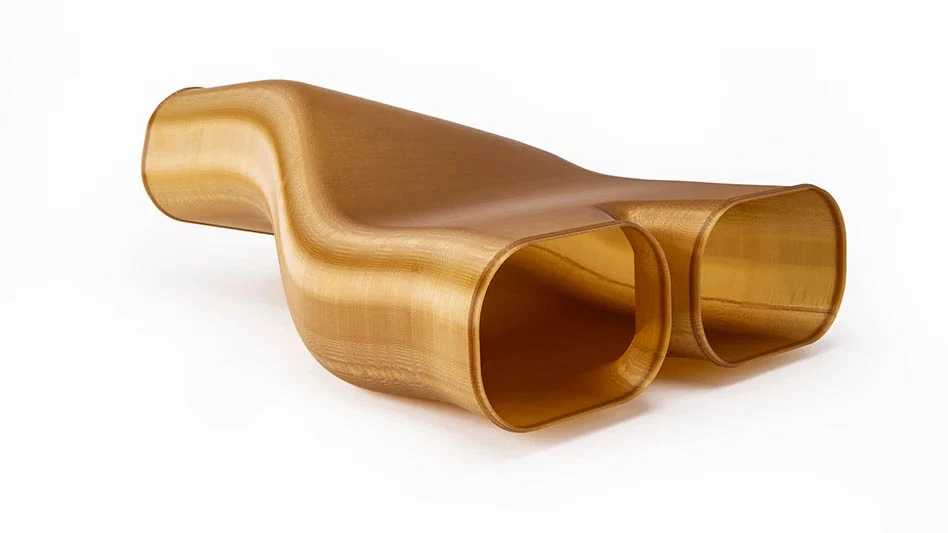
Composites have become indispensable in aircraft construction and are becoming more and more important in the automotive industry. However, they are difficult to process and machine. It is primarily carbon fiber reinforced plastics where the fiber is embedded in a matrix, but also composites made from layers of materials, which make extreme demands on processing machines and tools.
 Prof. Dr.-Ing. Frank Barthelmä, Managing Director of Society for Production Engineering and Development (GFE) e.V., Schmalkalden, draws attention to some key challenges: The risk of delamination, very short service life of tools, and the extraction of arising dust particles. "For the solution of such problems it is necessary to deal with the entire process chain for processing composites: starting with the machine concept, the process parameters, the quality of the component, together, and of course also with the tool." GFE managed to optimally adapt tools in an iterative process to the processing task. "With suitable processing technologies such as brush polishing, micro-finishing with drag finishing or micro-blasting, it is possible to reproduce precisely defined cutting edge radii of a few micrometers – and along the entire cutting edge of the tool." This is particularly important for combination or multistage tools to avoid delamination, according to Barthelmä. Another step is the coating. Oxynitride coatings with embedded oxygen have proved particularly effective and the tool life in comparison to traditional solid carbide tools is more than double. The Schmalkalden-based machining experts are expecting even better results from diamond-like coatings (DLC – Diamond-Like Carbon), which could become an efficient alternative to the very expensive polycrystalline diamonds (PCD) or chemical vapor deposition (CVD) diamond tools.
Prof. Dr.-Ing. Frank Barthelmä, Managing Director of Society for Production Engineering and Development (GFE) e.V., Schmalkalden, draws attention to some key challenges: The risk of delamination, very short service life of tools, and the extraction of arising dust particles. "For the solution of such problems it is necessary to deal with the entire process chain for processing composites: starting with the machine concept, the process parameters, the quality of the component, together, and of course also with the tool." GFE managed to optimally adapt tools in an iterative process to the processing task. "With suitable processing technologies such as brush polishing, micro-finishing with drag finishing or micro-blasting, it is possible to reproduce precisely defined cutting edge radii of a few micrometers – and along the entire cutting edge of the tool." This is particularly important for combination or multistage tools to avoid delamination, according to Barthelmä. Another step is the coating. Oxynitride coatings with embedded oxygen have proved particularly effective and the tool life in comparison to traditional solid carbide tools is more than double. The Schmalkalden-based machining experts are expecting even better results from diamond-like coatings (DLC – Diamond-Like Carbon), which could become an efficient alternative to the very expensive polycrystalline diamonds (PCD) or chemical vapor deposition (CVD) diamond tools.The machine tool manufacturers must also contribute. Barthelmä says, "High speeds with new, encapsulated spindles are one of the requirements for processing composites. High machine dynamics and the option of multi-axis milling are also required, as this is the case with 5-axis side and simultaneous machining." The industry is also pinning high hopes on machining using hybrid manufacturing methods such as ultrasonic-assisted milling.
Costs must drop despite individual solutions
Peter Büttler, responsible for lightweight construction activities at the Komet Group, summarizes how heterogeneous the requirements are: "On the one hand, the fibers differ in material, length, thickness, and fiber direction. On the other hand, over 100 different resins are available on the market for the matrix: Thermosetting plastics and thermoplastics, which have to be machined cold, and elastomer, where high cutting speed is key and the frictional heat in the flute must remain low." Close collaboration between the user and tool manufacturer is also equally important. "We check all relevant factors in advance such as the material to be machined, as well as the machining technology." For instance, it makes a difference whether a machining center, robot or manual processing machines are used. The workpiece clamping and the associated vibration risks are also taken into account. Other factors: cooling, speeds, the actual machining task and the extraction.
 A universal tool for as many applications as possible would be desirable, "there is currently no efficient solution, because the extremely inhomogeneous composites lay down very different requirements," explains Prof. Dr.-Ing. Diethard Thomas, manager of the LMT Group Academy. Generally with composite materials the tool must be customized. In the case of composites made from layers of materials, there could be a solution in terms of efficiency, "adjusting cutting values to the toughest material partner, for example, for composites made from CFRP/aluminum or CFRP/titanium." Thomas sees a permanent need for advancement, as the materials are constantly changing and being optimized due to their high costs (approx. 50% of costs): "As a result, there are always new requirements being placed on the tool design for the further optimization of the machining process; tool designs and cutting-value recommendations are thus constantly in a state of flux."
A universal tool for as many applications as possible would be desirable, "there is currently no efficient solution, because the extremely inhomogeneous composites lay down very different requirements," explains Prof. Dr.-Ing. Diethard Thomas, manager of the LMT Group Academy. Generally with composite materials the tool must be customized. In the case of composites made from layers of materials, there could be a solution in terms of efficiency, "adjusting cutting values to the toughest material partner, for example, for composites made from CFRP/aluminum or CFRP/titanium." Thomas sees a permanent need for advancement, as the materials are constantly changing and being optimized due to their high costs (approx. 50% of costs): "As a result, there are always new requirements being placed on the tool design for the further optimization of the machining process; tool designs and cutting-value recommendations are thus constantly in a state of flux."Aribert Schroth, product specialist for extremely hard cutting materials at the tool manufacturer Paul Horn, warns against always only comparing composites to carbon fiber reinforced plastics. "Related groups can by all means be machined with the same tools, however different machining parameters."
A similar approach is adopted at the tool manufacturer Mapal. Dr. Peter Müller-Hummel, manager of the business division Aerospace & Composites: "Often the requirements comply; then we always choose the more critical case and can thus cover many less critical cases." Another focus is helping the customer save costs in other ways. Müller-Hummel explains: "The machining in a single work process instead of three to five process steps currently has the highest potential." In addition, special coatings for tools enable a higher tool life and as a result, lower the costs per bore hole.
 It is generally necessary to significantly increase the efficiency with the wear of the tools. Paul-Horn-Mann Schroth states: "The processes which lead to the cutting blades wearing have not yet been fully researched and understood." He draws our attention to another aspect, connected to the requirement of tool manufacturers: "Prevention would be even more effective in the development stage of the material. Stricter and clearly defined guidelines in the manufacture would also have a positive effect on the efficiency."
It is generally necessary to significantly increase the efficiency with the wear of the tools. Paul-Horn-Mann Schroth states: "The processes which lead to the cutting blades wearing have not yet been fully researched and understood." He draws our attention to another aspect, connected to the requirement of tool manufacturers: "Prevention would be even more effective in the development stage of the material. Stricter and clearly defined guidelines in the manufacture would also have a positive effect on the efficiency." The current trend towards less resin content and strictly unidirectional alignment of the fibers has proved advantageous, as the material becomes more predictable as a result. The lightweight construction expert views the resulting stronger delamination as controllable: "The cutting edge must be sharp and also has to retain its sharpness, almost every tool is right for this purpose." The sensor system can be definitive here. Schroth adds, "In addition to wear detection, which is the biggest advantage, the vibration behavior of the component is fundamental for the function and service life of the tool used."
Accurate wear detection is also a prerequisite for development at the wbk Institute of Production Science in Karlsruhe. There the scientific employee Stefan Klotz examined the material damage caused by tool wear when boring. He noticed that with the tool wear "the wear conditions of the cutting edge change, which leads to changing process force directions and increasing workpiece damage". Klotz therefore suggests a "dynamic adaptation of the process parameters to the current wear state of the tool" in order to specifically reduce the "damage to the top layers."
The processing of composites generally places high requirements on technology development. Patrick Diederich, managing director of Sauer GmbH in Pfronten, a subsidiary of DMG Mori, explains: "A combination of diverse materials, which leads to extremely anisotropic material behavior, requires constant optimization of all process data, tools, as well as the cooling lubricant selection." In addition to the actual processing, the subsequent process steps such as bonding, painting, or further processing also have to be taken into consideration. Almost all trimming tasks require multi-axis milling. "For the five-axis side and simultaneous processing, the dynamics of the individual axes should be optimally coordinated, because only this way can quick positioning and reorientation be guaranteed for demanding processing tasks," Diederich emphasizes.
 But the machine tools themselves could also benefit from composites. Engineers at DMG Mori are currently examining areas where these materials offer advantages. Florian Feucht, manager of the Development Department at Composite Sauer in Stipshausen: "In the initial approach we are focusing on moving masses and increasing energy efficiency with the aim of achieving a high degree of dynamics with corresponding sustainability." Another interest is the possibility of compensating thermally induced displacements with the use of carbon fibers. "We are handling this very well with the current materials." Also at MAG, composites are now more highly valued for the construction of machine tools, primarily when it comes to dynamics, as Matthias Meyer explains: "In many areas our machines must accelerate masses in a short time."
But the machine tools themselves could also benefit from composites. Engineers at DMG Mori are currently examining areas where these materials offer advantages. Florian Feucht, manager of the Development Department at Composite Sauer in Stipshausen: "In the initial approach we are focusing on moving masses and increasing energy efficiency with the aim of achieving a high degree of dynamics with corresponding sustainability." Another interest is the possibility of compensating thermally induced displacements with the use of carbon fibers. "We are handling this very well with the current materials." Also at MAG, composites are now more highly valued for the construction of machine tools, primarily when it comes to dynamics, as Matthias Meyer explains: "In many areas our machines must accelerate masses in a short time."Get curated news on YOUR industry.
Enter your email to receive our newsletters.
Loading...
Latest from Aerospace Manufacturing and Design
- July is for learning – so drop in for this month’s second Manufacturing Lunch + Learn
- Essential strategies to protect your data
- NASA selects instruments for Artemis lunar terrain vehicle
- Twin-cutter boring head
- Bell awarded funding for X-plane build phase of SPRINT program
- Shaft coupling clamps
- #46 Lunch + Learn Podcast with SMW Autoblok
- Gleason Corp. acquires the Intra Group of Companies





